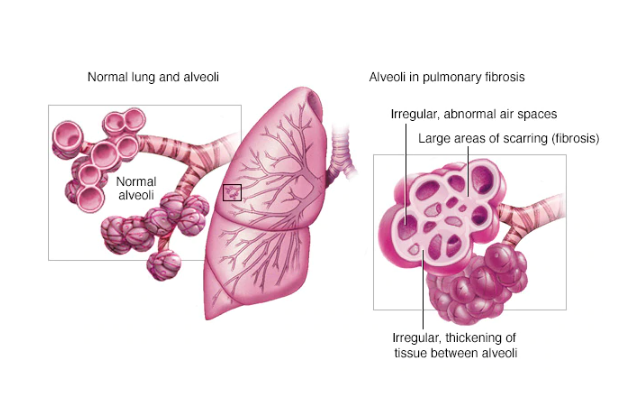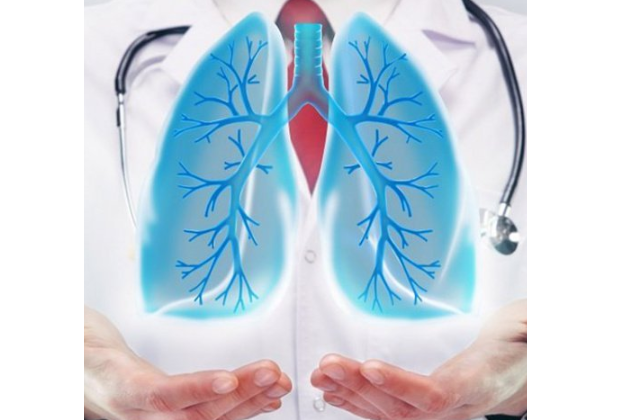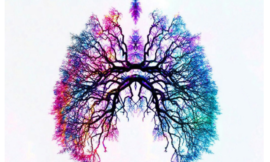Idiopathic pulmonary fibrosis (IPF) is a type of lung disease that results in scarring (fibrosis) of the lungs for an unknown reason. Over time, the scarring gets worse and it becomes hard to take in a deep breath and the lungs cannot take in enough oxygen.
IPF mostly affects middle-aged and older adults, and there is no cure. Everyone’s outlook is different,so the progress of the disease varies from person to person. Some people will get worse quickly, while others can live 10 years or more after diagnosis.
There are many other kinds of interstitial lung disease that can also cause inflammation and/or fibrosis, and these are treated differently. It is important to work with your doctor to determine if you have IPF or another form of interstitial lung disease.
Symptoms
Signs and symptoms of pulmonary fibrosis may include:
- Shortness of breath (dyspnea)
- A dry cough
- Fatigue
- Unexplained weight loss
- Aching muscles and joints
- Widening and rounding of the tips of the fingers or toes (clubbing)
The course of pulmonary fibrosis — and the severity of symptoms — can vary considerably from person to person. Some people become ill very quickly with severe disease. Others have moderate symptoms that worsen more slowly, over months or years.
Causes
The cause of idiopathic pulmonary fibrosis is not completely understood. No one knows what causes idiopathic pulmonary fibrosis or why some people get it. “Idiopathic” means of unknown cause. Common risk factors for IPF include:
- Genetics (family history): Up to 20% of people with IPF have another family member with an interstitial lung disease. If more than one member of your family has IPF, the disease is called familial pulmonary fibrosis.
- Cigarette smoking: Approximately 75% of people with IPF are current or previous cigarette smokers.
- Acid reflux (gastroesophageal reflux disease [GERD]): Approximately 75% of people with IPF have symptoms of acid reflux or heartburn.
- Male sex: Approximately 75% of patients with IPF are male.
- Age: Almost all patients with IPF are over the age of 50 years.
Idiopathic Pulmonary Fibrosis Diagnosis

Pulmonary fibrosis is suggested by a history of progressive (worsening over time) shortness of breath with exertion. Sometimes, during examination of the lungs with a stethoscope, the doctor can hear crackling sounds in the chest. These crackles have a very characteristic sound and are very similar to the sound heard when Velcro is pulled apart. These are often referred to as “Velcro crackles (or rales).
C. T Scan will frequently demonstrate abnormalities. This type of X-ray provides a cross-sectional picture of the lungs in very detailed resolution. The classic findings in idiopathic pulmonary fibrosis show diffuse peripheral scarring of the lungs with small bubbles (known as bullae) adjacent to the outer lining of the surface of the lung, often at the bases of the lungs.
The diagnosis of pulmonary fibrosis can be confirmed by lung biopsy. An open surgical biopsy, meaning that the chest wall must be surgically opened under general anesthesia to remove a portion of lung tissue, may be necessary to obtain enough tissue to make an accurate diagnosis. The biopsy specimen is examined microscopically by a pathologist to confirm the presence of fibrosis.
Idiopathic Pulmonary Fibrosis Treatment
Treatments for idiopathic pulmonary fibrosis won’t cure the disease, but they can make it easier for you to breathe. Some may keep your lungs from getting worse quickly.
Medicine: Two drugs, nintedanib (Ofev) and pirfenidone (Esbriet), are approved to treat IPF. Scientists are still finding out exactly how they work in the lungs, but they know that these treatments can slow lung scarring and damage. Corticosteroids can ease lung inflammation in some people during a flare-up of the disease.
Most of the people are take medication as per their doctors advice, but in some places the availability of the medicine is limited, on this case lots of online pharmacies are providing these medicines at reasonable price. GDMeds is an Indian pharmacy which provide this medicine at a good price, they providing pirfenidone medicine manufactured by cipla. we can directly visit their website and place order. There are also other pharmacies like 984degree, anukar, 1 mg etc.
Oxygen therapy: You breathe oxygen through a mask or prongs that go in your nose. It boosts the oxygen in your blood so you have less shortness of breath and can be more active. Whether you need to wear oxygen depends on how serious your condition is. Some people with IPF need it only when they sleep or exercise. Others need it 24 hours a day.
Pulmonary rehabilitation: You work with a team of doctors, nurses, and therapists on ways to manage your symptoms. You might focus on exercise, healthy eating, relaxation, stress relief, and ways to save your energy. You may visit the hospital for a rehab program or do one at home.





